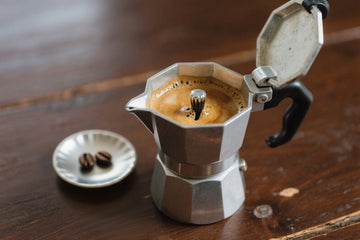The Moka Pot, an Italian stovetop coffee maker, has long been shrouded in myths. Some claim it brews bitter coffee, while others insist it can’t produce crema. Let’s debunk these misconceptions and unlock the secrets to a smooth, rich brew with a velvety layer of crema.
Myth 1: Stovetop Pressure = Espresso
Reality: A Moka Pot operates at 1–2 bar of pressure, far below the 9 bar required for true espresso. This means you won’t get the same thick crema as a machine, but with the right technique, you can still achieve a golden, frothy layer. The key lies in controlling extraction time and water temperature.
Myth 2: High Heat = Stronger Coffee
Reality: Overheating is the #1 cause of burnt, bitter coffee. The Moka Pot’s design relies on gentle steam pressure to push water through grounds. Here’s how to master heat control:
1.Preheat Water: Fill the bottom chamber with water heated to just below boiling (80–90°C). This shortens brewing time, reducing the risk of over-extraction.
2.Low-to-Medium Heat: Place the pot on medium-low heat. As soon as coffee begins to flow into the upper chamber, reduce heat to low.
3.Stop Early: Listen for a gurgling sound—this signals the water chamber is nearly empty. Immediately remove the pot from heat and run the base under cold water to halt extraction. This prevents residual heat from scorching the coffee.
Myth 3: Any Bean Will Work
Reality: Bean selection is critical. Avoid dark roasts, which dominate the Moka Pot’s concentrated brew. Instead, opt for:
-
Medium Roasts: Look for beans with caramel or nutty notes, like Colombian or Ethiopian varieties. These roasts balance sweetness and acidity.
-
High-Altitude Beans: These tend to have natural sweetness and lower acidity, reducing bitterness.
-
Freshness Matters: Use beans ground just before brewing. Stale grounds produce flat, burnt flavors.
The Secret to Crema: Aeration and Emulsification
While true espresso crema forms under high pressure, Moka Pot crema relies on two factors:
1.Grind Size: Aim for medium-fine (finer than drip coffee, coarser than espresso). Too fine? Water struggles to pass through, leading to over-extraction. Too coarse? Coffee tastes weak and sour.
2.Gentle Agitation: After brewing, swirl the pot gently to emulsify oils, creating a light foam. For an extra boost, pour coffee from a height into a preheated cup to aerate it.
Pro Tips for Perfect Brew
-
Don’t Tamp the Grounds: Unlike espresso, pressing down coffee in the Moka Pot’s filter basket restricts flow and causes bitterness. Just level the grounds with your finger.
-
Clean Thoroughly: Old coffee oils build up in the pot, turning brews rancid. Rinse with hot water after each use and descale monthly with vinegar or citric acid.
-
Experiment with Ratios: Start with a 1:10 coffee-to-water ratio (e.g., 20g coffee to 200ml water) and adjust to taste.
The Verdict
The Moka Pot isn’t a poor man’s espresso machine—it’s a unique brewing method that delivers bold, aromatic coffee with a hint of crema when done right. By debunking myths about pressure, heat, and beans, you can transform your stovetop routine into a barista-worthy experience. So grab your Moka Pot, some fresh beans, and start brewing—your taste buds will thank you.






